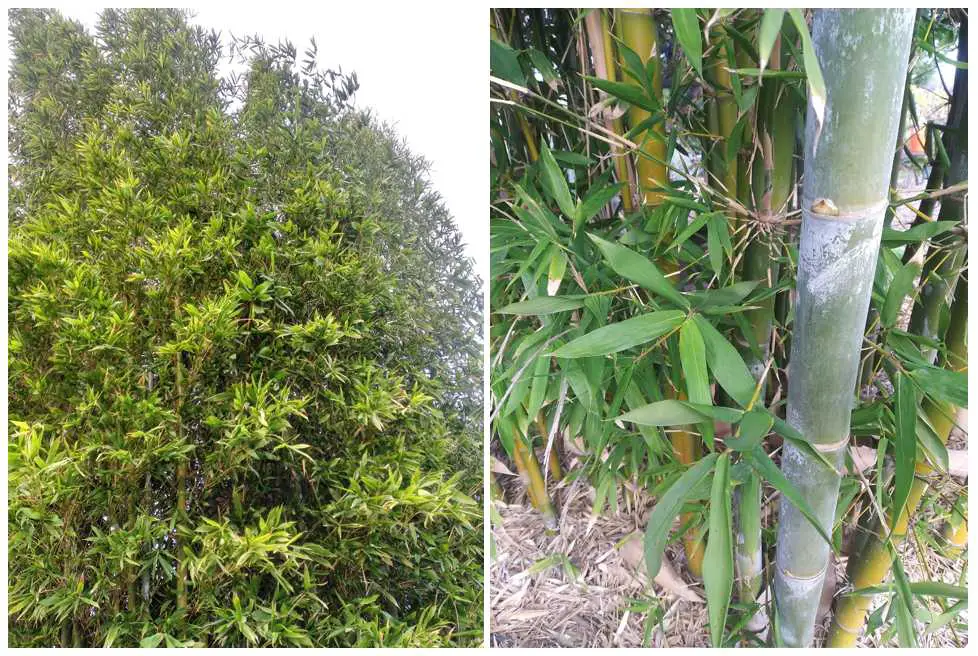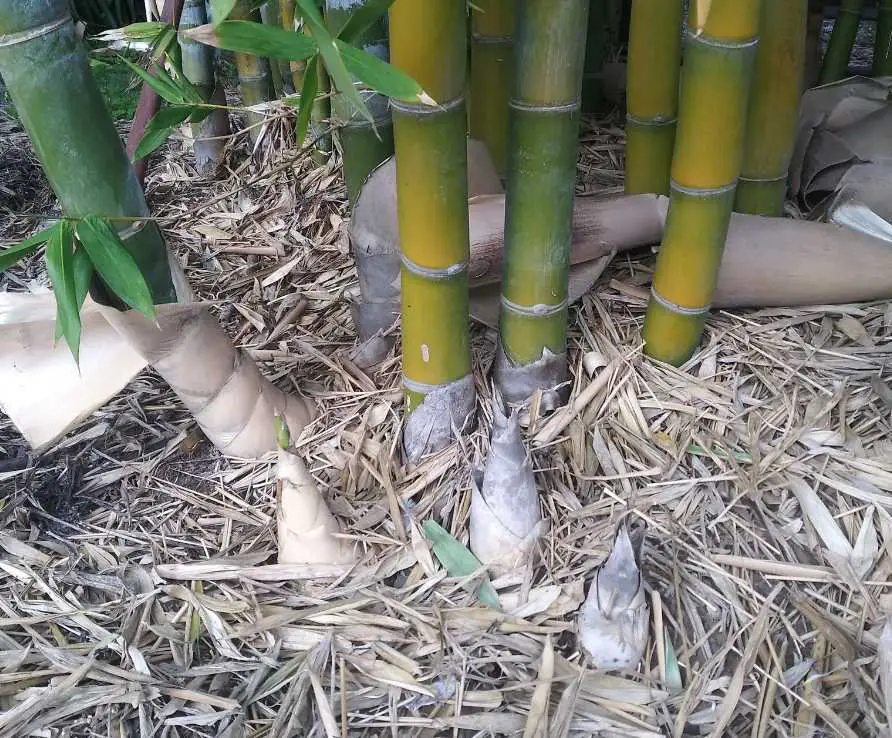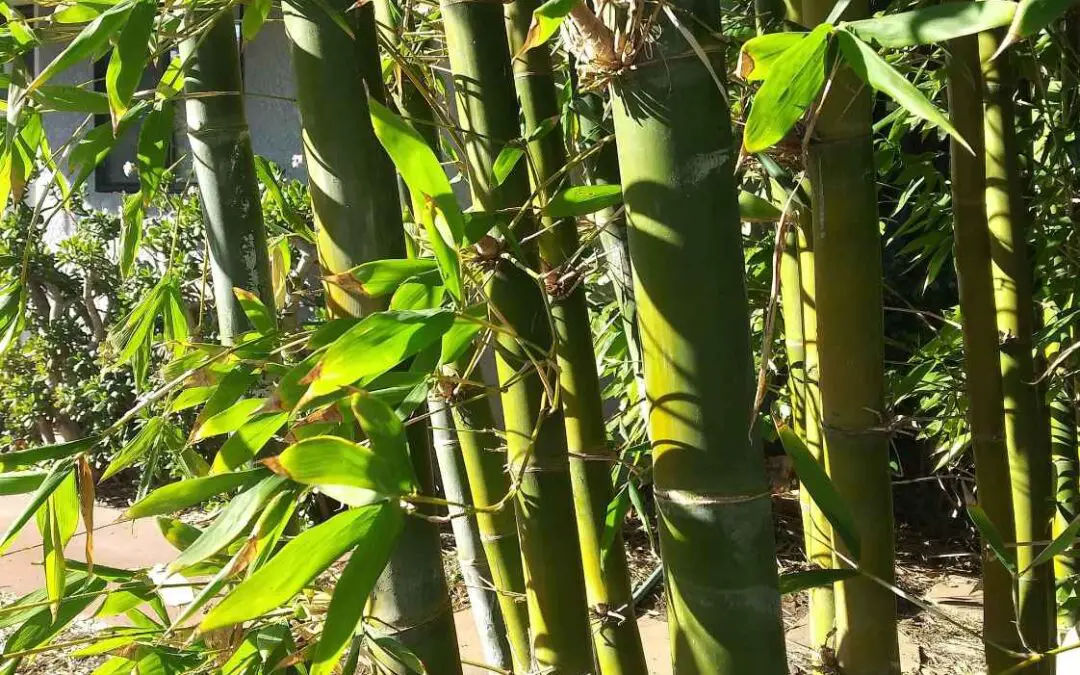Finding the best bamboo for your garden is not easy. There are many factors to consider, such as your climate, the desired size, the desired use, and so on. But if you live in a relatively warm climate with mild winters, and you want a bamboo that will reach for the sky without invading the rest of your garden, Bambusa oldhamii might be the way to go.
Bambusa oldhamii, also called Chinese Timber Bamboo or simply Oldham’s, is a subtropical, clumping variety native to China and Taiwan. A timber species, Oldham’s can grow more than 50 feet tall in the right conditions. Culms are straight, upright and strong, about 3 to 4 inches thick, with a powdery green color that gradually fades to yellow. The plant prefers a climate where frost is rare, but it’s cold-hardy down to about 20º F. Shoots are edible.
This article is part of an ongoing series about different species and cultivars of bamboo. To learn more, check out some of these other detailed articles.
- BAMBOO SPECIES GUIDE
- A gallery of bamboo species
- Black Bamboo: Phyllostachys nigra and others
- Buddha’s Belly Bamboo
- Chimonobambusa quadrangularis: Square Bamboo
- Golden Bamboo: Phyllostachys aurea and others
- Hiroshima Bamboo
- Pseudosasa amabilis: Tonkin Bamboo
- Purple Bamboo: An online phenomenon
Characteristics of Bambusa oldhamii
People have a hard time distinguishing between different species of bamboo. True enough, a lot of them look extremely similar. But there are a handful of characteristics that set Oldham’s apart from the others. And these are also the traits that make it such a popular choice among gardeners.
Clumping growth habit
All members of the genus Bambusa belong to the tropical tribe of bamboo, meaning they are all clumpers. This is what most gardeners want, because the running varieties have earned bamboo such a horrible reputation.
Because of the nature of their rhizome roots, a running bamboo can spread and take over lawns and gardens, often choking out other ornamental plants. And once the tenacious roots of a running bamboo establish themselves, they can be almost impossible to remove. As a result, many gardeners are afraid to plant any bamboo at all. Unfortunately, this is a matter of misinformation and mismanagement in most cases. In fact, there are a number of ways to contain and tame a running bamboo.
Many gardeners are not familiar with clumping bamboo. Partly that’s because most clumpers will not grow in cold climates where snow is common. But clumping varieties, like Bambusa, have a different type of root system. Instead of spreading always outwards, parallel to the ground, the clumping bamboo rhizomes always bend upward in a U-shape. Therefore, the new shoots, which will grow to be towering poles, will come up very close together.
Bambusa oldhamii is a clumper, so it has a limited footprint, usually not more than 10 or 15 feet across. You can also prune new shoots to keep it even smaller and thin out the older, less attractive culms from the center of the clump. As it clumps, it will not continue to spread out or put up shoots in surprising places all around your garden. Rather, you will be able to keep it in a well-defined area, without disrupting the rest of the landscape or creeping into the neighbor’s well-manicured flower bed next door.
A towering timber bamboo
Oldham’s is notable for its size. It’s not as big as the giant Dendrocalamus or Gigantochloa varieties of Southeast Asia, but as an ornamental in a residential garden, it’s quite impressive. In favorable conditions, a healthy Oldhamii will grow 50 to 60 feet tall with culms about 3 to 4 inches in diameter.

The poles of this species are tall, straight and elegant. Furthermore, the wood is thick and makes a beautiful building material. They are not strong enough for serious construction, but they are great for building furniture or making other crafts. Compared to running bamboo, tropical bamboo poles are generally less likely to crack.
The combination of clumping roots and timber size make Bambusa oldhamii an especially appealing and popular variety of bamboo. It’s particularly interesting for those who want to dazzle their neighbors without overrunning their gardens.
Climate conditions for B. oldhamii
Although native to the subtropical climes of Taiwan, Bambusa oldhamii also does quite well in the temperate climate zones of southern Europe and North America. It’s not the most cold-hardy of bamboos, but Oldham’s will survive down to about 20 degrees Fahrenheit, which is pretty hardy for a clumping bamboo. In other words, most of the West Coast and the Southeast offer perfectly good conditions for this species.
The most cold-hardy bamboos tend to be running species, like members of the genus Phyllostachys. Phyllostachys are native to the cooler and more mountainous parts of China and Japan, where snowy winters are the norm. Most of them can tolerate temperatures down to about 0º F or less. This makes them especially popular in places like the Midwest, Germany and Canada, which we don’t generally associate with bamboo. Oldham’s won’t grow in those climates without a greenhouse, but it does enjoy a pretty wide range of habitats.
Oldhamii for dinner
Like many, but certainly not all species of bamboo, B. oldhamii has edible shoots. They are considered something of a delicacy in Asian cuisine. Furthermore, many bamboo farmers sell the edible shoots and consider that to be the best way to earn money from their bamboo crop. You might call it the low-hanging fruit. Unlike other bamboo products that enterprising entrepreneurs may explore, the shoots do not require any heavy machinery or processing equipment.

Before you dig up a tender shoot and dice it into your green salad, please be careful. The raw shoots contain a natural toxin that can make you very sick to your stomach. To make these shoots palatable, you’ll need to boil them for at least half an hour or so. You can also ferment them, like pickles or sauerkraut. This is one of the traditional means of preparation.
Dense greenery
Rounding out the list of desirable characteristics, Oldham’s is not only tall, regal, hardy and well-contained, but it’s also bursting with attractive greenery. The leaves of this species are long and wide, growing densely between the majestic culms of the towering bamboo. Most of the branching and lush foliage doesn’t start until around a quarter of the height of the plant. From there and upwards, the bushy leaves can provide some comforting privacy for your second-story windows, as well as some excellent nesting areas for avian wildlife.
Alternatives to Oldhamii
Oldham’s is one of the most popular species of ornamental bamboo in the United States. But perhaps you want something else. In other parts of the tropical and subtropical world, Bambusa vulgaris is very widespread, and the golden cultivars of this species are especially attractive as ornamentals.
If it’s too cold to grow Bambusa in your climate zone, but you want something of comparable size and stature, then try a big Phyllostachys. Phyllostachys bambusoides, or Japanese Timber Bamboo, is a beautiful variety. It has a running growth habit, but the culms are tall, elegant and vibrant green. It’s very similar in size to Oldhamii, but be sure to use some kind of root barrier to prevent spreading.
Phyllostachys nigra ‘Henon’ is also very similar to Japanese Timber. Also called Giant Gray, the culms have a dusty green hue, and are about the same size as the other two.
If your climate is even warmer, with little or no chance of frost, you can get a true tropical bamboo. I’d suggest a species of Dendrocalamus. D. giganteus is one of the biggest and most impressive, but D. latiflorus has a sublime beauty that’s hard to beat. Hitam, a subspecies of D. asper, with deep, dark coloration, almost black, is an exceptional stand-out. If you’re looking for a bit of contrast against a field of jolly green giants, this is the one. (Hitam means black in Indonesian.)
The etymology of Bambusa oldhamii
Behind every scientific species name, there’s a story. But some are better than others. Bambusa vulagaris, for example, is Latin for common bamboo. Not so exciting. Sasa kurilensis, on the other hand, takes its name from the island of its origin, in an archipelago at the center of a territorial dispute between Russia and Japan. Yes, bamboo from eastern Russia.
Evidently, B. oldhamii was discovered in Taiwan in the 1860s by an unfortunate British botanist and collector named Richard Oldham. Over the course of his adventures through Asia and Japan, Oldham contracted smallpox, rheumatism and neuralgia, and ultimately died of dysentery at the age of 27. He may have died young, but he lived well, and his name is sure to live on, thanks to the overwhelming popularity of this bamboo species.
Further reading
Finding the perfect plant for your garden isn’t easy, but with bamboo, you can have a ton of fun. There are thousands of species of this amazing grass, and hundreds of ornamental varieties to consider. Start with a trusted favorite like Oldham’s and later you can diversify into more exotic and complementary species.
To learn more, take a look at some of our other articles about bamboo gardening and maintenance. And please consider subscribing to our blog for more great articles about the uses and cultivation of this incredible plant.


























The clumps of my bambusa are about 20 years old. Although new shoots are still emerging from the perimeter, how do I get new shoots to emerge from the now bare center of the clump?
I’d suggest cleaning out the old stumps and rhizomes from the bare center, to make room for new and more vigorous rhizomes.
Hello, is B.oldhamii a good choice for troughs, in Napa, CA.?
The climate in Napa would be great for Oldhamii, but it’s not the best choice for a container. It’s a clumping species, so it won’t spread, but eventually the clump will get 10-12 feet in diameter. The plant will be happier and easier to maintain when grown directly in the ground.